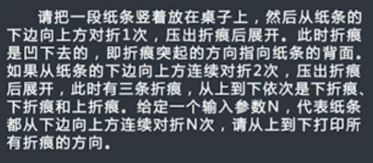
I saw this question more than once. Written examination and interview.
You take a paper fold a fold will find something like this:

Tree left subtree is the bottom half of the points, the right subtree is the upper half of the paper.
It refers to the direction the fold crease is a rear projection sheet.
It can be seen crease is a full binary tree, the root node is at the crease, each child left subtree is on the crease, every child the right subtree is lower crease.
Printing was the RVL binary tree (root left and right) traversal from above to below the paper.
Refers folded N times N layer node.
/**
* 请把纸条竖着放在桌⼦上,然后从纸条的下边向上⽅对折,压出折痕后再展开。
* 此时有1条折痕,突起的⽅向指向纸条的背⾯,这条折痕叫做“下”折痕 ;
* 突起的⽅向指向纸条正⾯的折痕叫做“上”折痕。如果每次都从下边向上⽅ 对折,
* 对折N次。请从上到下计算出所有折痕的⽅向。
* 给定折的次数n,请返回从上到下的折痕的数组,若为下折痕则对应元素为"down",
* 若为上折痕则为"up".
* <p>
* 从纸的上面到下面打印就是二叉树的RVL(右根左)的遍历。
*
* @param n
* @return
*/
public static String[] foldPaper(int n) {
List<String> result = new ArrayList<>();
fold(1, n, "down", result);
return result.toArray(new String[result.size()]);
}
private static void fold(int level, int n, String type, List<String> result) {
if (level <= n) {
//R
fold(level + 1, n, "down", result);
//V
result.add(type);
//L
fold(level + 1, n, "up", result);
}
}
